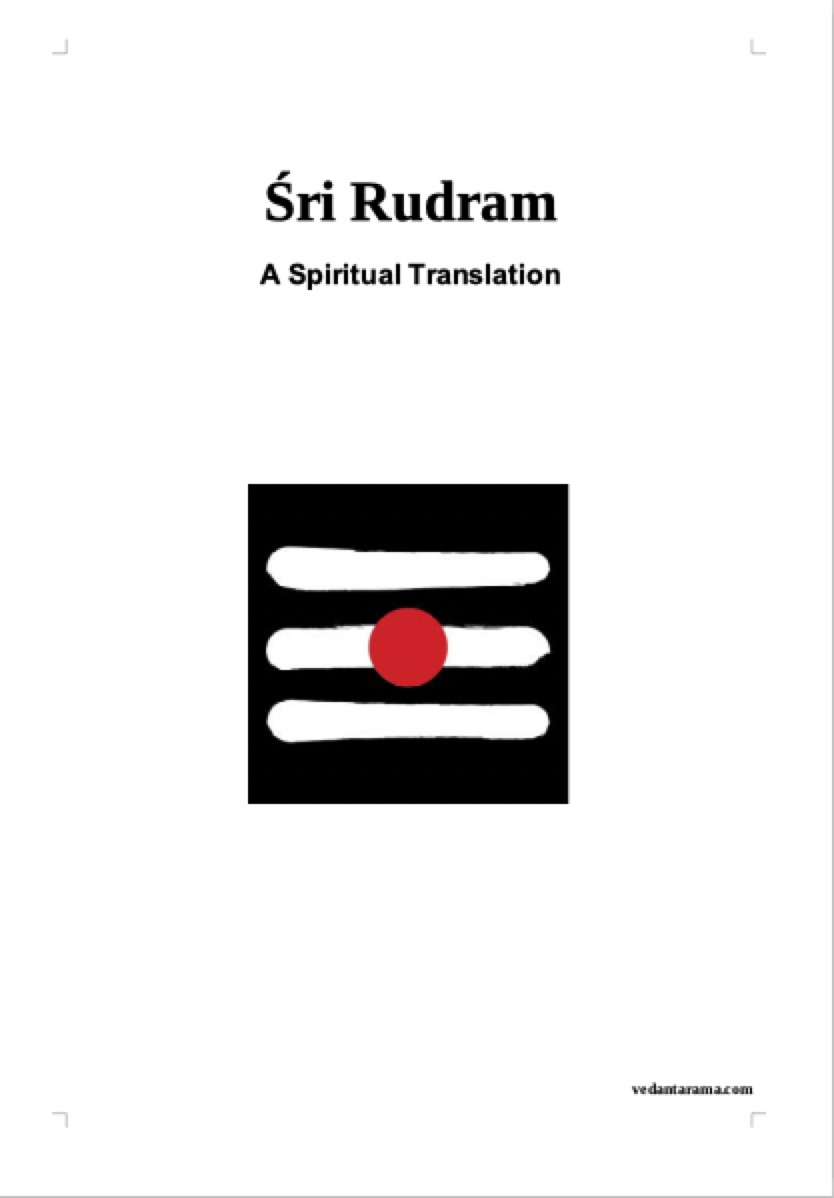Rudram – Learning Resources

Following my fascination with Rudram I chanted this mystical hymn every morning without break for 2108 days.
This sadhana has left a profound and evolving impact on the subtle pathways of my mind.
I wish to share this generosity of vision with others who may be interested in hearing, studying or chanting Rudram themselves.
Harih Om
Derek
What is Rudram

Rudram is a profound Sanskrit hymn of great significance. In its written form it is more than 3000 years old. The content is mystical and cannot be fully explained in conventional ways but can be appreciated.
As a highly respected sacred text, Rudram is chanted in Shiva temples as part of the daily ceremony and in specific ritual where multiple repetitions can take place over many days. As well as these temple settings Rudram also has a popular affection amongst devotees across the world for personal worship, inspiration and spiritual practice.
To grasp the essence of Rudram is to understand it as a recognition of the majesty of God, expressing as everything, everywhere, both around us and within us. The whole universe in all its aspects and parts is a single grand divinity within which we find ourselves living this compelling human life. The mantras of Rudram seek to align to the auspicious in three liberating ways:
Practical – influencing our lives for security, benevolence and welfare
Devotional – expressing awe and wonder for the divinity of existence
Mystical – purifying spiritual intelligence toward Self-realisation
Siva is a central theme in Rudram carrying a multitude of meanings. A direct translation of the word Siva itself means ‘auspicious’, apparent in us all as the power and potential for goodness. In our best moments we are capable of experiencing altruism, enthusiasm, insight, love, kindness, tolerance, purity of heart and clarity of vision. It is these possibilities that we appeal to and invite. It is their opposites, as obstacles and ignorance, that we seek to be protected from, address and overcome.
Rudram contains twenty two verses known as anuvakas and is in two separate parts. First Namakam, naming multiple aspects of the wonder of nature as the abundance of God in form, characterised by the repetition of the word Namah meaning ‘salutations’.
Chamakam follows, containing eleven mantra sections. It is a prayer for the blessings needed in life to live well, express generosity and fulfil potential, characterised by the repetition of the phrase Ca me meaning ‘to me’. The word me is inclusive, rather than singular, displaying the generous and gregarious nature of Rudram
The Sound of Rudram
Rudram - male and female voice - recorded by Derek & Anna 2019
Rudram - male voice - recorded by Derek 2019

I made the recordings above in summer 2019 along with my Rudram chanting partner Anna. Without formal Sanskrit backgrounds we have worked together over several years to learn Rudram and come as close as possible to a reasonable accuracy of chanting for our English voices.
The pronunciation of Sanskrit is not automatically intuitive especially for western speakers. This needs to be studied and assimilated otherwise chanting will not articulate the intended sounds. It is quite easy to gain sufficient competence in this to begin chanting and then aspire to improve over time just as we have continued to do.
The combination of the male and female voice in the first example is powerful and beautiful, evocative of the passion and dynamic of nature itself. The second example is given for its different energetic impact
Chanting Script

All chanters and learners need a good, accurate and manageable chanting script. Fortunately, through the efforts of others, we have available a full and clear text of the whole Rudram in transliterated Romanised script, including accent marks for chanting.
Most western students of Rudram will want to see the text presented in Romanised script but this is of course a variation on the original. The source material of Rudram is in the original characters of Sanskrit Devanagari script. This is also provided here both for beauty, interest and for those who can read the characters or wish to learn them
English Translation

This English translation of Rudram took two years of precise and intense work to produce. The translation gives the literal meaning of each individual mantra. The mystical meaning is also given for those seeking deeper spiritual understanding of themselves and the intimacy of God.
This is particularly of value for those who understand, or at least suspect, that there is an immense divine reality in the everyday world around us and within us, to which the mantras of Rudram point and reveal.
Once understood it is apparant that Rudram speaks to the inner world within us, as much as it does to the world without. The obstacles, the potential and the possibilities are then all aspects of our own mind, as it moves toward the evolutionary trajectory of expansion into beauty.
This A4 book is a private publication and not on general sale. If you are interested in having a copy for your personal spiritual study into the mystery of Rudram you can contact us
Extract from Introduction
In the 15th century BCE when the Rudram was written down, the principle of oneness of the cosmos was fully known and fully expressed, not in the concepts of physics but in poetic, religious and mystical language. The culture and time was very different but the intelligence and insight was not by any measure inferior. In terms of the nature of consciousness, it was far superior, displaying a purity and sophistication that is breath-taking
Structure of the Translation
The text is focussing on a spiritual rather than material interpretation of Rudram and is arranged in the following way…
1. The number of the individual mantra
2. The original Sanskrit text
3. A direct translation of the Sanskrit
4. An interpretation conveying the spiritual meaning
Translation Namakam 1.1
om nama̍ste rudra ma̱nyava̍ u̱tota̱ iṣa̍ve̱ nama̍h
nama̍ste astu̱ dhanva̍ne ba̱hubhyā̍mu̱ta te̱ nama̍h
Oh Rudra, salutations to your ferocity and to your arrow,
salutations to your bow and to your two arms which wield the bow
and hold the arrow, salutations.
The power of Rudra stands poised with arrow aimed, bow drawn and quiver full,
ready to strike in correction, to restore balance. His powers of nature are immense and formidable and I am helpless before him.
I give salutations to that glory and humbly seek his mercy helpless before him.
Translation Chamakam 1.1 (sample)
vāja̍śca me prasa̱vaśca̍ me̱ praya̍tiśca me̱ prasi̍tiśca me dhī̱tiśca̍ me̱ kratu̍śca me̱ svar̍aśca me̱ śloka̍śca me śrā̱vaśca̍ me̱ śruti̍śca me̱ jyoti̍śca me̱
Food to me, purity to me, right attitude to me, continuation to me, loss of ego to me, strength to worship to me, constant remembrance of God to me,
capacity to instruct to me, capacity to listen to me, illumination to me.
The prayer for food and other vitalities calls for all aspects of nourishment to come to me for the attainment of an effective and wholesome life. These gifts include gross food to sustain life, subtle energy to experience a bright intelligent mind and the subtlest and purest ananda that is the essence of spiritual sustenance.
Learning to Chant

It is not necessary to chant Rudram yourself unless you have a strong desire to do so. Great benefit is experienced by being a respectful and open hearer of the chant. Listening in this way is all that is required as the energetic and sacred nature of Rudram impacts upon you, invoking well-being, inspiration and wonder. It is as if people are given a moment of relief from all the noise and movement otherwise occupying the mind and in that moment experience a wordless awe.
This is the nature of spiritual surrender where the dominant mind gives way to the wordless heart. Stillness, silence, peace and spiritual openness is the common impact in those who are able to do that.
If however you are inspired to learn to chant yourself then following this instinct is a profound thing to do. It is best to start at the beginning and learn one anuvaka at a time. If you are dedicated you could complete the whole process in a year but that would be rare. Realistically it is likely to take between one and three years to gain a competent grasp of the whole flow of Rudram and be able to repeat the sounds in a reasonable way.
Your learning will be a milestone in your life, a time of challenge, inspiration, obstacle and thrill. This is symbolic of Rudram itself and indeed symbolic of spiritual evolution in you.
Comprehensive and well presented online materials for hearing how to sound and read the mantras are provided here by Satya Sai Trust